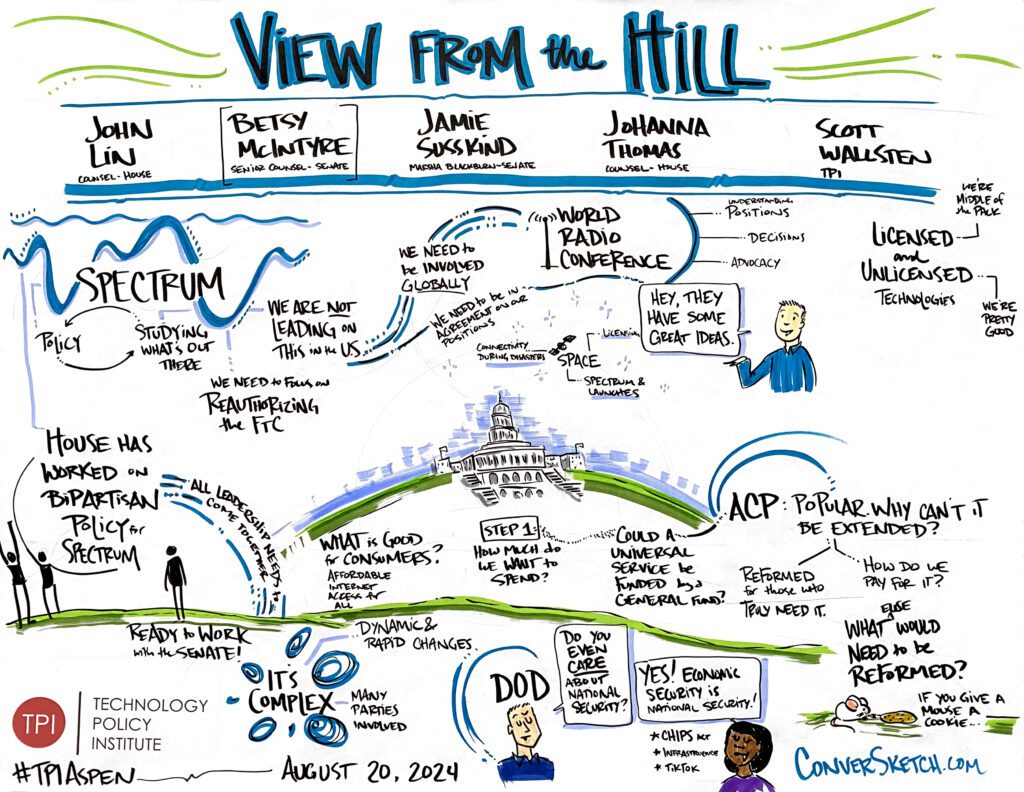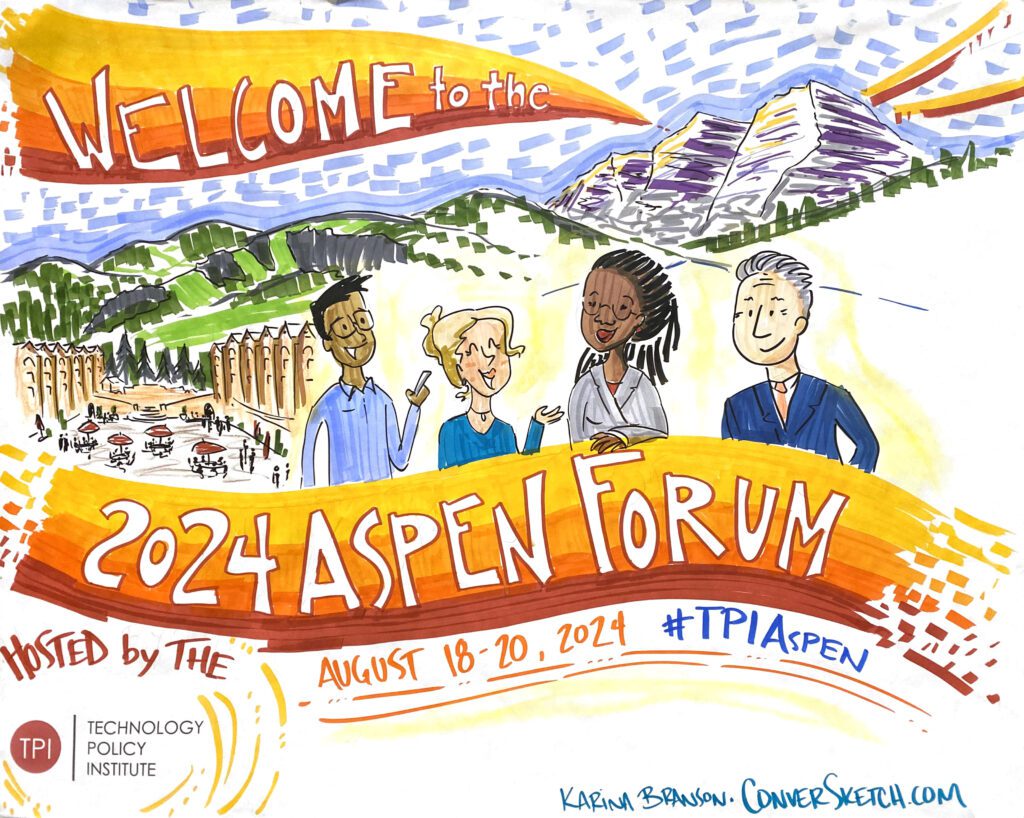
The Economic Impact of AI
Read the transcript here.
Panelists: Timothy Bresnahan, Carol Corrado, Jeffrey Prince, Michael Rosenbaum
Moderator: Scott Wallsten
- The AI revolution is a continuation of the computer revolution, with top-heavy rates of adoption concentrated on companies with the resources to develop and implement GenAI tech. These companies have a competitive advantage in securing the high-quality data needed to train advanced LLMs. The current AI landscape is narrow and deep: only a small percentage of companies, mostly large tech firms, have integrated AI into their business. The broader market has yet to fully embrace AI. If AI usage were to expand, it could bring about an enormous productivity boom.
- AI drives productivity gains in key sectors, such as healthcare and engineering, by enhancing predictive recruiting practices. AI expands opportunity for those at the bottom end of the income scale, but may soon displace some aspects of high-income jobs, like medical diagnoses. Still, human beings have a natural edge in trust and information flow that machines can’t replicate.
- Discussions of whether AI is infinitely bad or good are useless, but debating the merits of AI on specific points has utility. Just as hallucinations don’t render AI useless with the proper safeguards, inventive work to deal with risk improves GenAI.

How Should We Regulate the Digital World?
Read the transcript here.
Panelists: Peter Brown, Andrew DeVore, Kat Duffy, Adam Thierer
Moderator: Alan Raul
- The digital world encompasses AI, human rights, national security, intellectual property, and more. Regulatory action that lumps the digital world together is ineffective and has unintended consequences.
- Regulating rapidly evolving technologies like AI is exceedingly difficult, particularly when the full impacts and use cases are not yet known.
- Regulators must recognize that rules involve tradeoffs between, in this case, promoting innovation and addressing potential harms or risks from digital technologies.
- Any regulatory approach should be adaptable to rapidly evolving technologies and involve collaboration between government, industry, and international partners, although panelists did not agree on what that meant. Some panelists advocated for flexible, industry-led “soft law” approaches that allow for innovation while addressing specific risks. Others argued for more government involvement and formal regulatory frameworks.
- Some argued that the US market-driven approach has fostered more digital innovation, although others cautioned against oversimplifying this narrative. Panelists also expressed concern about the fragmented nature of US regulation, with state-level initiatives potentially complicating national coherence. The Biden administration’s executive order on AI was discussed as an attempt to provide federal direction, though its effectiveness and impacts are not known.
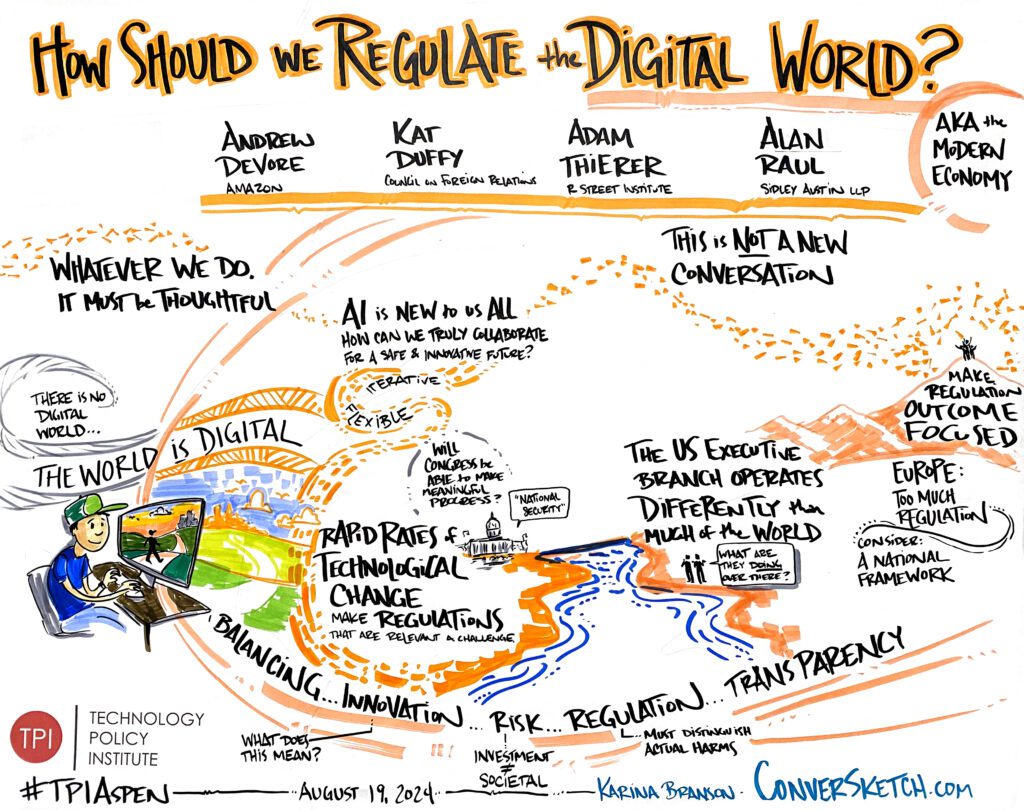
Fireside Chat: AI & Copyright Policy
Read the transcript here.
Shira Perlmutter & Joel Waldfogel
- “Digital replicas,” AI-created imitations of real people’s appearances, voices, or actions, often made without consent, are a key issue driving concerns about AI. High-profile examples, such as replicas of Taylor Swift, President Biden, and former President Trump have drawn attention to the issue.
- Copyright law typically requires human authorship. The U.S. Copyright Office, which administers copyright laws and advises other parts of government on copyright policy, maintains that AI-generated content can be copyrighted only when humans were significantly involved in its creation. Courts, Congress, and other government agencies are beginning to refine law on AI copyright.
- Economic analysis is key for the future of copyright policy in the AI era. Copyright law is designed to incentivize and protect innovation by giving creators the exclusive right to their works. AI may stifle creativity by giving rise to derivative works based on existing copyrighted content. It may also have negative effects on creators’ livelihoods and lead to job displacement for certain actors, artists, or translators.
- Fully addressing AI and copyright challenges requires international cooperation. Perlmutter highlighted the risk of regulatory arbitrage, where different copyright rules across jurisdictions could lead to forum shopping for AI development.
- The Copyright Office aims to balance fostering AI innovation with protecting creators’ rights. Perlmutter emphasized the need to ensure that AI technology can thrive and develop efficiently while simultaneously safeguarding and maintaining incentives for human creativity.
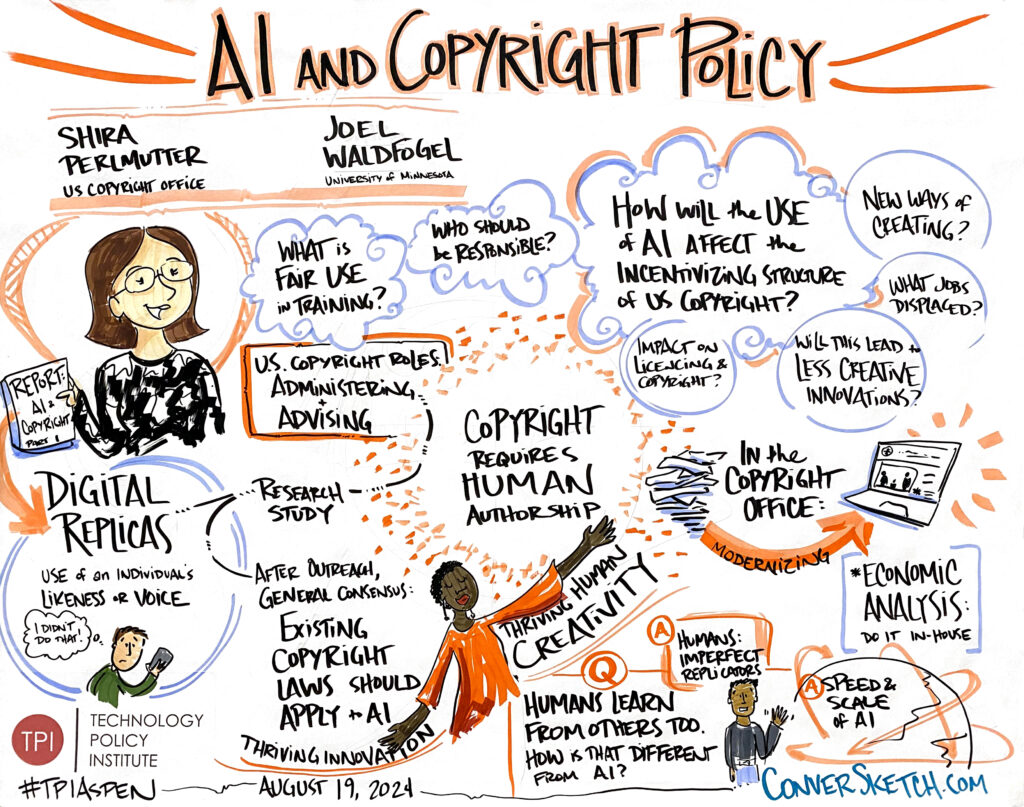
The Policy Implications of New Broadband Competition
Read the transcript here.
Panelists: Will Adams, Johannes Bauer, Michelle Connolly, Jay Schwarz
Moderator: Scott Wallsten
- 5G fixed wireless and low earth orbit satellites like Starlink are competing with traditional broadband providers and increasing connectivity in rural areas. Fixed wireless in particular has grown rapidly, accounting for 8.6 million new broadband subscribers.
- Some expressed concern about the affordability of these new options and thus whether they can help with the income digital divide. Panelists discussed the merits of supply (infrastructure) subsidies versus direct demand subsidies (vouchers) to increase accessibility as critical services move online (like telehealth) and address specific consumer needs.
- Government programs, like the Universal Service Fund and BEAD, largely favor fiber networks over more flexible and immediate connectivity solutions like fixed wireless or LEO satellites. Fiber is the gold standard, but is expensive to deploy and takes time to deploy in rural areas.
- A mixed approach focuses on fiber in central areas while wireless or satellite covers harder-to-reach places. Low-income, rural communities may prefer immediate, lower quality connectivity solutions but panelists suggested conducting surveys to let these communities shape solutions. Meanwhile, government policy should evolve to reflect the potential of new technologies like Starlink as legitimate competitors to traditional broadband given their potential to provide affordable and widespread access.
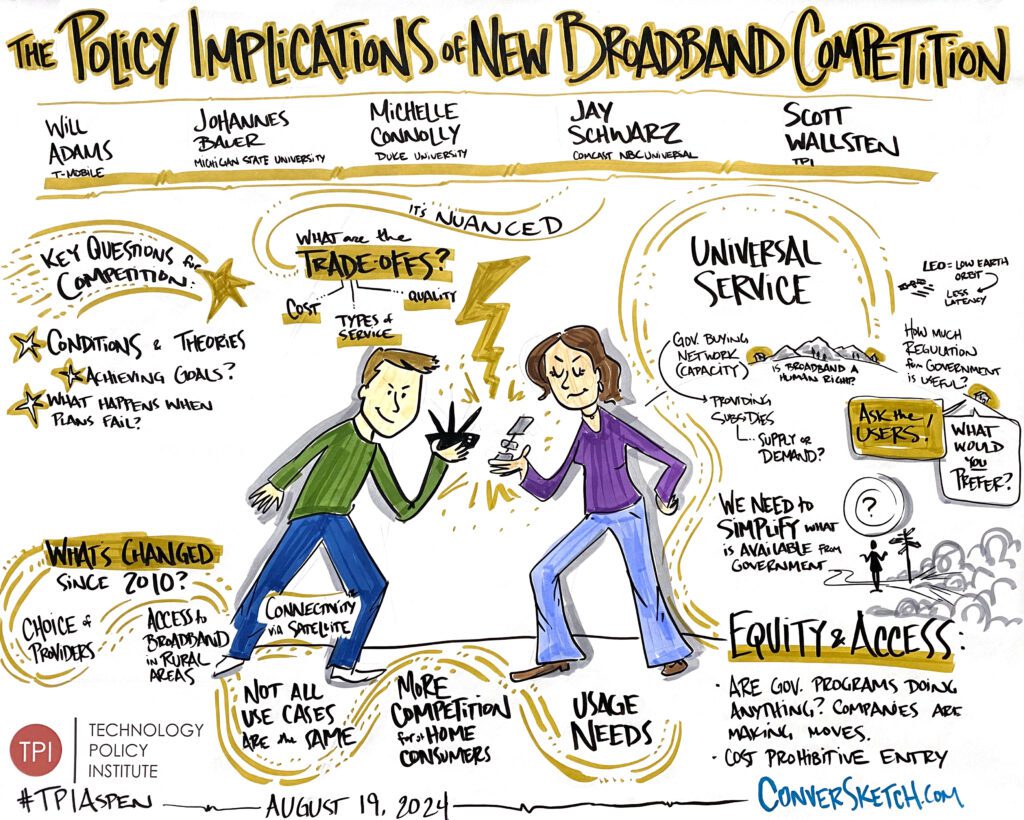
The Telecom Regulators
Panelists: Anna Gomez, Konstatinos Masselos, Adam Scott, Geoffrey Starks
Moderator: Bryan Tramont
- 5G development faces infrastructure and workforce challenges. The U.S. tackles the issue through large-scale federal funding programs like BEAD, but workforce availability is another concern: 5G expansion requires a diverse network of technicians and engineers to manage the move toward millimeter-wave spectrum.
- The U.S. Affordable Connectivity Program (ACP) was critical to low-income households seeking broadband services, but funding has run out. In Europe, regulatory policies enable private investment in broadband networks. Canada leverages a public-private partnership, where low-income households can access discounted broadband.
- LEO satellites, such as Starlink’s, are being integrated into rural broadband strategies. LEO satellites have the potential to extend coverage to highways and remote areas where other networks are economically unfeasible.
- Broadband deployment within each country differs due to geographic, financial, and regulatory challenges. For instance, Canada struggles to deploy long fiber links to remote communities. Greece has excellent 5G coverage but low fiber penetration. The EU focuses on fostering an investment-friendly, unified regulatory regime to transition from legacy copper to high-capacity fiber networks.
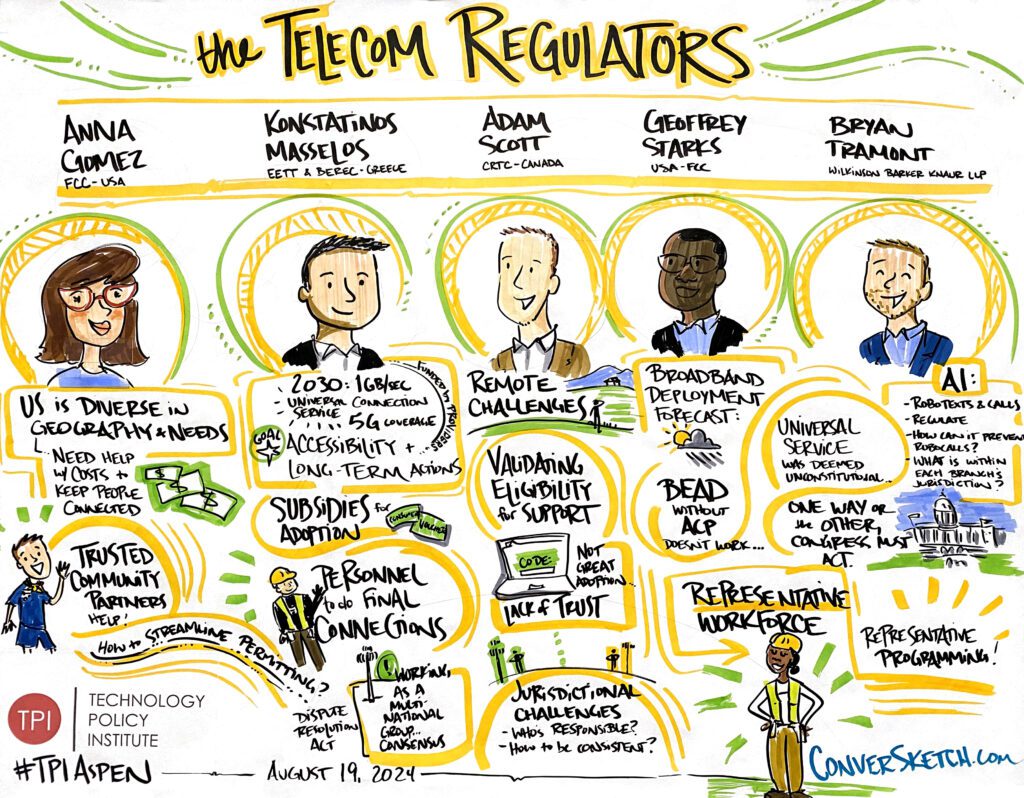
Trust, Safety and Content Moderation
Panelists: Karen Courington, Matt Perault, Patrick Warren
Moderator: Sarah Oh Lam
- Content moderation is a core function for many platforms, involving AI-powered tools and human moderators. While AI shows promise, its current impact on moderation effectiveness is still limited.
- Inauthentic behavior (in particular trolls and bots) as an ongoing concern, particularly around elections. They described efforts by trust and safety teams to detect and address these activities across multiple platforms.
- The panel addressed the disparity in resources between large and small platforms for content moderation. Panelists noted that smaller companies and startups often lack access to advanced moderation tools and infrastructure, potentially putting them at a competitive disadvantage. Some speakers suggested that open-source tools and industry collaboration could help address this gap.
- Content moderation practices need more transparency. Panelists suggested that users often don’t understand moderation decisions, which can lead to confusion and frustration. Part of the problem stems from the lack of legal and policy clarity. Panelists noted that recent court rulings haven’t provided definitive guidance, leading to uncertainty about various policy interventions.
- Some panelists called for more research to evaluate the effectiveness of different moderation approaches, while also noting concerns about research in this field. Some speakers suggested that political pressures and funding changes might affect studies on misinformation and content moderation.
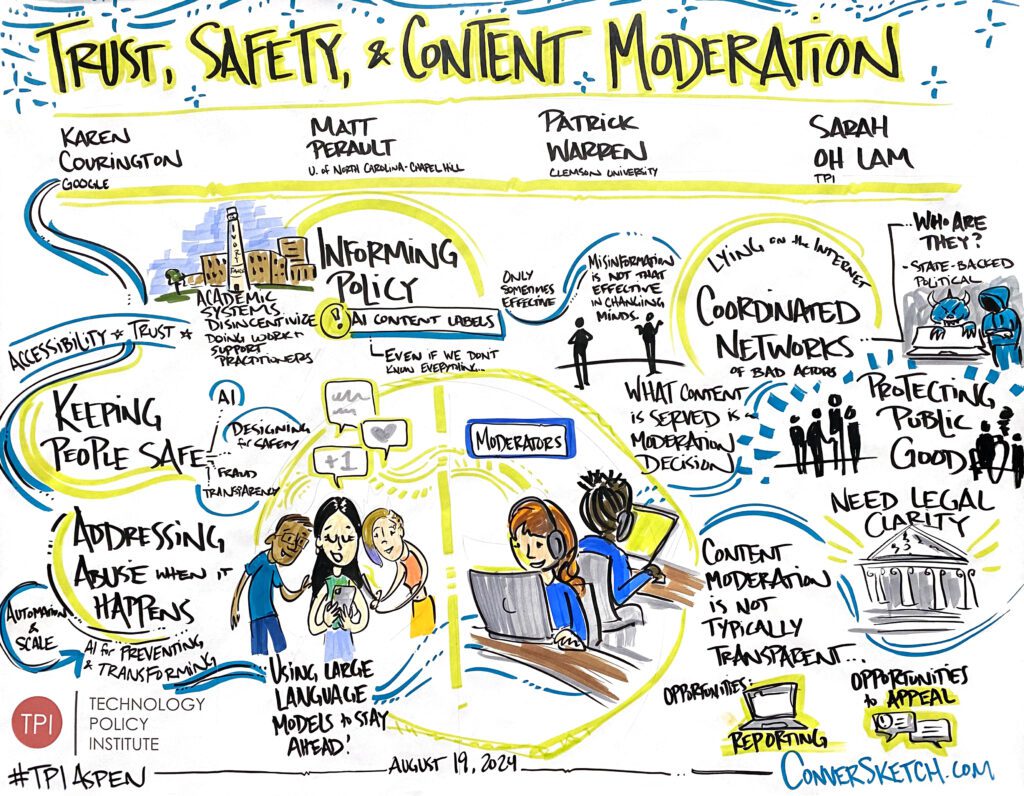
Fireside Chat with the New FTC Commissioners
Read the transcript here.
Panelists: Andrew Ferguson, Melissa Holyoak
Moderator: William Kovacic
- Judicial skepticism: The FTC’s unprecedented unanimous losses in cases like Axon and AMG signal increasing judicial skepticism. The commissioners emphasized that the FTC must earn judicial deference through sound empirical work, careful case selection, and consistent wins to maintain its “deposit of credibility” with courts.
- Post-Chevron Interpretation: Post-Chevron, the commissioners stressed the importance of rigorous statutory interpretation and “showing our work.” Commissioner Holyoak used the healthcare breach notification rule to illustrate how agencies must now demonstrate their interpretations are correct– not just reasonable– through careful textual analysis. Both highlighted the tension between needed regulatory flexibility and constitutional constraints on delegation.
- Consumer Protection as Antitrust Focus: Consumer protection must remain antitrust enforcement’s “lodestar,” with resources focused where consumer harm is greatest, particularly fraud targeting vulnerable populations. Commissioner Ferguson argued that existing antitrust laws, if fully used, could address many Big Tech concerns without new legislation.
- Coordination vs. Fragmentation: The commissioners acknowledged both the benefits of interstate cooperation and the value of regulatory fragmentation. They suggest that the decentralized U.S. system promotes innovation by avoiding the centralization seen in European regulatory models.
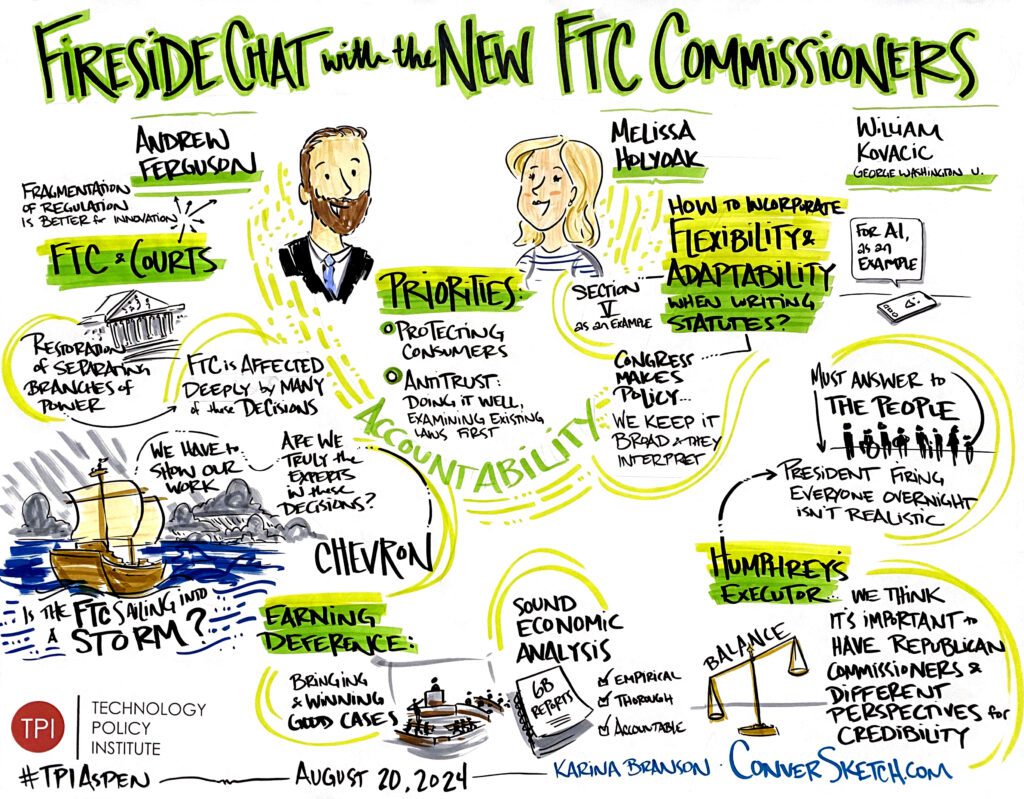
Antitrust: The Next Four Years
Read the transcript here.
Panelists: Robert Crandall, Ginger Jin, Michael Katz, William Kovacic
Moderator: Tom Lenard
- Complex Debate Over Antitrust’s Role: Significant disagreement exists about whether antitrust is the appropriate tool to address Big Tech concerns. As several panelists noted, many issues (like privacy and misinformation) may lie outside antitrust’s scope.
- Google Decision’s Implications: The recent Google Search decision focused on exclusive distribution agreements. The decision contains notable ambiguities, particularly regarding what specific conduct was illegal and the lack of a clear “but-for” competitive scenario. As panelists noted, the judge rejected state claims and limited findings on monopoly power, suggesting a careful, mainstream approach.
- Evolving Remedial Approaches: The panel explored various potential remedies, from prohibiting exclusivity contracts to mandating data sharing. Panelists suggested the DOJ will likely propose multiple options – including both behavioral and structural remedies – to give the judge room to choose a middle path. Some panelists noted that data sharing might be seen as a “safer” remedy compared to structural changes like divesting Chrome or Android.
- Innovation and Competition Dynamics: The relationship between firm size and innovation emerged as more complex than often portrayed. For example, large firms sometimes fund smaller firms’ innovations, and the prospect of acquisition can motivate innovation by smaller firms. A key debate centered on whether large tech companies should be restricted from expanding into adjacent markets, even through organic growth, with some panelists questioning the implications of forcing firms to “stay in their lane.”
- Regulatory Frameworks and International Impact: The panel expressed significant skepticism about the EU’s Digital Markets Act (DMA) approach, particularly its hands-on regulation of product design. Panelists discussed how companies are struggling with compliance costs and suggested this might lead to fragmentation of tech policies across regions, as companies may need to maintain distinct regimes in different parts of the world.
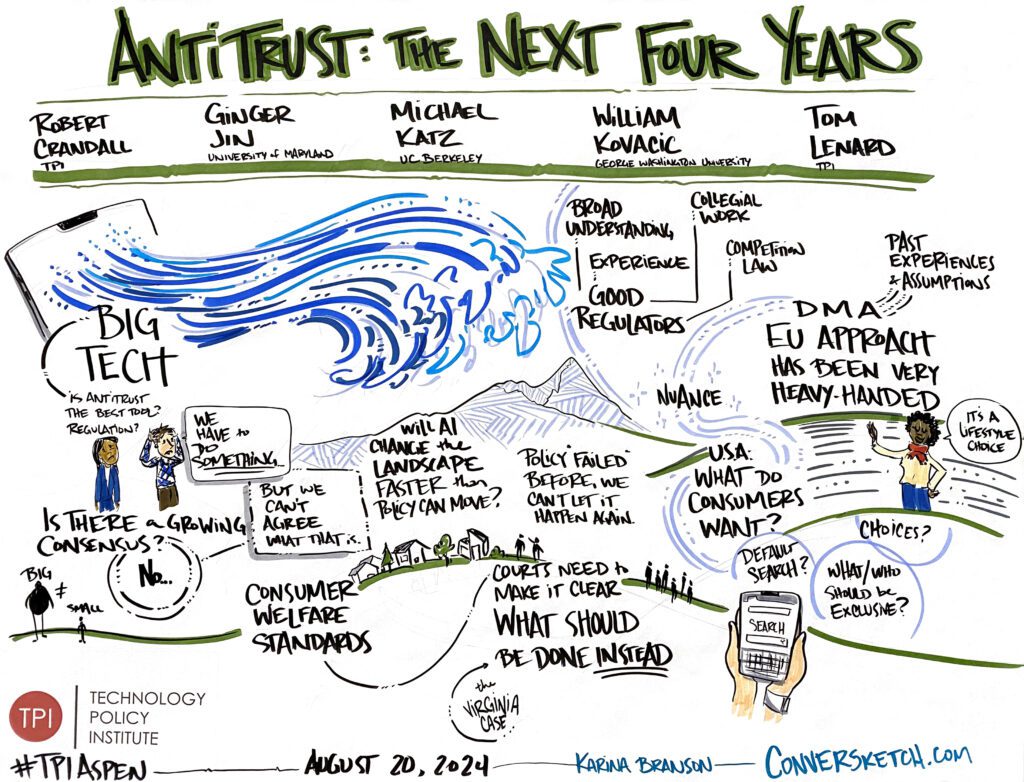
View from the Hill
Read the transcript here.
Panelists: John Lin, Jamie Susskind, Johanna Thomas
Moderator: Scott Wallsten
- Renewing Spectrum Authority: The FCC’s general spectrum auction authority, lapsed for over a year, has raised concerns about the U.S. having less spectrum available for commercial uses than other countries. . Panelists emphasized the need for Congress to reauthorize this power immediately to manage spectrum and avoid delays in future auctions.
- Congress and Spectrum Policy: Panelists highlighted the vital role Congress must play in driving spectrum policy. Panelists highlighted the complexity inherent in spectrum management due to many stakeholders involved (DOD, FAA, FCC, and more).
- Global Spectrum Leadership: To maintain U.S. leadership in global spectrum policy, strong advocacy from representatives of the Department of State, NTIA, and FCC is essential at international forums like the ITU and the World Radio Conference. Without U.S. leadership, it becomes easier for countries like China to gain greater influence at standards bodies.
- The Way Forward for ACP: The panel debated the path forward for funding universal broadband programs like the ACP. With an eye toward budgetary constraints, the panel discussed how bipartisan working groups in Congress could identify long-term funding sources (even through general revenues) to provide stable support without relying on temporary funding patches.
- National Security in Spectrum: Recognizing the Chinese government’s influence in telecommunications, Congress has passed multiple acts to protect U.S. communications security, strengthen U.S. companies, and combat Chinese influence. The Rip and Replace program, the Secure Equipment Act, and recent Congressional hearings on the issue all aim to address risks posed by foreign adversaries.
